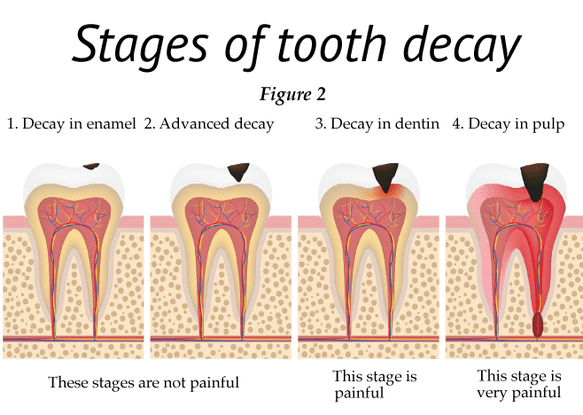Cavities, those pesky little troublemakers often known as tooth decay, are a common oral health concern that doesn’t discriminate when it comes to age. You may recall the discomfort or dread associated with a dental visit due to the mention of cavities. While we are aware that these dental nuisances are detrimental to our pearly whites, it’s crucial to grasp the fundamental science behind their formation and the straightforward steps we can take to prevent them. We won’t dive too deep into the complexities of dental biochemistry. Instead, we’ll take a straightforward approach to understanding how cavities form and how you can actively guard your teeth against their development. It’s all about ensuring that your smile remains radiant and healthy.
The Formation of Cavities: A Step-by-Step Process
Cavities form as a result of a complex interaction between oral bacteria, dietary choices, and your tooth structure. Here’s a detailed breakdown of the key steps in the cavity formation process:

- Oral Bacteria and Plaque Formation: It all starts with the presence of oral bacteria in your mouth. These bacteria consume sugars and carbohydrates from your diet, producing acids as byproducts. When bacteria accumulate on your teeth, they form a sticky film known as plaque.
- Acid Production and Enamel Erosion: Plaque is the breeding ground for harmful acids. These acids attack your tooth enamel, which is the hard, protective outer layer of your teeth. Enamel begins to weaken as it loses essential minerals through a process called demineralization.
- Cavity Formation: As enamel continues to erode, small holes or weak spots develop on the tooth’s surface. These weak spots are the early stages of cavities. If the process is not halted, these spots can progress into full-fledged cavities.
- Cavity Growth: Once a cavity has formed, it will continue to grow and deepen if left untreated. Bacteria and food particles can become trapped inside the cavity, leading to further decay.
Preventive Measures to Prevent Cavities
The good news is that you can take several proactive measures to prevent cavities and maintain a healthy smile. Here are some key preventive steps:
- Oral Hygiene: Regular brushing and flossing are the cornerstone of cavity prevention. Brush at least twice a day and floss once a day to remove plaque and food particles from your teeth and gums.
- Fluoride Use: Fluoride is a mineral that strengthens tooth enamel and makes it more resistant to acid attacks. Use fluoride toothpaste and consider professional fluoride treatments.
- Balanced Diet: Limit sugary and starchy foods, as they provide fuel for harmful oral bacteria. Opt for a balanced diet rich in fruits, vegetables, and calcium-rich foods that benefit your oral health.
- Dental Check-ups: Regular dental check-ups are essential. Your dentist can detect early signs of cavities and provide timely treatment. Professional cleanings help remove plaque and tartar buildup.
- Sealants: Dental sealants are thin protective coatings applied to the chewing surfaces of molars and premolars. They act as a barrier against decay-causing bacteria.
- Drink Water: Water helps rinse away food particles and acid from your mouth. It’s an excellent choice, especially after consuming sugary or acidic foods and beverages.
- Chewing Sugar-Free Gum: Chewing sugar-free gum stimulates saliva production, which helps neutralize acids and strengthen tooth enamel.
Understanding the science of cavity formation empowers you to take control of your oral health. By following these preventive measures and maintaining good oral hygiene, you can significantly reduce your risk of cavities and enjoy a lifetime of healthy teeth. Regular visits to your dentist for check-ups and professional cleanings are also essential for early detection and treatment of any dental issues, ensuring that your smile remains vibrant and cavity-free. Don’t wait until a cavity forms; take proactive steps to protect your oral health and maintain a radiant smile for years to come.

